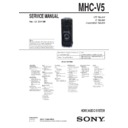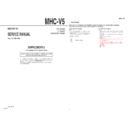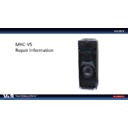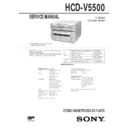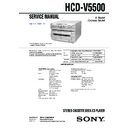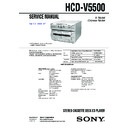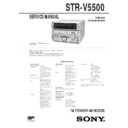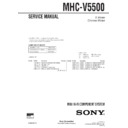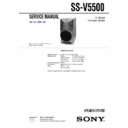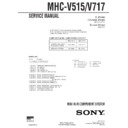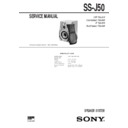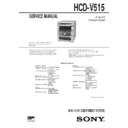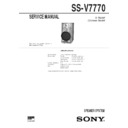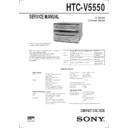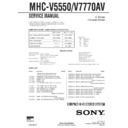Read Sony MHC-V5 Service Manual online
SERVICE MANUAL
Sony Corporation
Published by Sony Techno Create Corporation
US Model
E Model
Australian Model
SPECIFICATIONS
HOME AUDIO SYSTEM
9-893-954-04
2014H33-1
©
2014.08
Ver. 1.3 2014.08
Model Name Using Similar Mechanism
NEW
CD Mechanism Type
CDM90-DVBU202 or CDM90-DVBU204
Optical Pick-up Block Name
CMS-S76RFS7G or CMS-S76RFS7G1 or
CMS-S76RFS7GP
CMS-S76RFS7GP
Note:
Be sure to keep your PC used for service and
checking of this unit always updated with the
latest version of your anti-virus software.
In case a virus affected unit was found during
service, contact your Service Headquarters.
Be sure to keep your PC used for service and
checking of this unit always updated with the
latest version of your anti-virus software.
In case a virus affected unit was found during
service, contact your Service Headquarters.
MHC-V5
AUDIO POWER
SPECIFICATIONS
SPECIFICATIONS
POWER OUTPUT AND TOTAL
HARMONIC DISTORTION: (USA model
only)
HARMONIC DISTORTION: (USA model
only)
Left/Right Channel:
With 5 ohm loads, both channels
driven, from 800 – 20,000 Hz;
rated 150 watts per channel
minimum RMS powe r, with no
more than 0.7% total harmonic
distortion from 250 milliwatts to
rated output.
With 5 ohm loads, both channels
driven, from 800 – 20,000 Hz;
rated 150 watts per channel
minimum RMS powe r, with no
more than 0.7% total harmonic
distortion from 250 milliwatts to
rated output.
Amplifier section
Power output (rated):
Left/Right Channel: 320 W +
320 W (at 5 ohms, 1 kHz, 1% THD)
320 W (at 5 ohms, 1 kHz, 1% THD)
Power output (reference):
Left/Right Channel: 480 W +
480 W (per channel at 5 ohms,
1 kHz)
Subwoof er: 480 W (at 5 ohms,
100 Hz)
480 W (per channel at 5 ohms,
1 kHz)
Subwoof er: 480 W (at 5 ohms,
100 Hz)
Speaker section
Speak er system: Tweeter + Mid range
speak er + woofer
Tweeter L/R: 40 mm (1
in) cone type
Mid L/R: 100 mm (3
in) cone type
Woofer: 250 mm (9
in) cone type
Inputs
AUDIO IN/P ARTY CHAIN IN L/R:
Voltage 2 V, impedanc e
47 kilohms
47 kilohms
A (USB), B (USB) port:
Type A, maximum current:
500 mA
500 mA
Outputs
AUDIO OUT/P ARTY CHAIN OUT L/R:
Voltage 2 V, impedanc e 47
kilohms
kilohms
iPod/iPhone section
Made for
– iPhone 5s
– iPhone 5c
– iPhone 5
– iPhone 4s
– iPhone 4
– iPhone 3GS
–i Pod touch (5th generation)
–i Pod touch (4th generation)
– iPhone 5c
– iPhone 5
– iPhone 4s
– iPhone 4
– iPhone 3GS
–i Pod touch (5th generation)
–i Pod touch (4th generation)
Disc player section
System:
Compact disc and digital audio
system
system
Laser Diode Properties
Emission Duration: Continuous
Laser Output*: Less than 44. 6 μW
Laser Output*: Less than 44. 6 μW
* This output is the value
measur ement at a distance of
200 mm from the objective lens
surface on the Optical Pick-up
Block with 7 mm aperture.
200 mm from the objective lens
surface on the Optical Pick-up
Block with 7 mm aperture.
Frequency response:
20 Hz – 20 kHz
Signal-to-noise ratio:
More than 90 dB
Dynamic range:
More than 88 dB
Tuner section
FM stereo, FM/AM superheterodyne
tuner
Antenna:
tuner
Antenna:
FM lead antenna
AM loop antenna
AM loop antenna
FM tuner section
Tuning range:
Tuning range:
USA model:
87.5 MHz - 108.0 MHz (100 kHz
step)
Other models:
87.5 MHz - 108.0 MHz (50 kHz
step)
87.5 MHz - 108.0 MHz (100 kHz
step)
Other models:
87.5 MHz - 108.0 MHz (50 kHz
step)
AM tuner section
Tuning range:
Tuning range:
531 kHz – 1,710 kHz (9 kHz step)
530 kHz – 1,710 kHz (10 kHz step)
530 kHz – 1,710 kHz (10 kHz step)
BLUETOOTH section
Communic ation system:
BLUETOOTH Standard version 3.0
Output:
BLUETOOTH Standard Power
Class 2
Class 2
Maximum communic ation range:
Line of sight approx. 10 m
1)
Frequency band:
2.4 GHz band (2.4000 GHz –
2.4835 GHz)
2.4835 GHz)
Modulation method:
FHSS (Freq Hopping Spread
Spectrum)
Spectrum)
Compatible BLUETOOTH profiles
2)
:
A2DP (Advanced Audio
Distribution Profile)
AVRCP 1.3 (Audio Video Remote
Control Profile)
SPP (Serial Port Profile)
Distribution Profile)
AVRCP 1.3 (Audio Video Remote
Control Profile)
SPP (Serial Port Profile)
Supported codecs:
SBC (Sub Band Codec)
AAC (Advanced Audio Coding)
AAC (Advanced Audio Coding)
1)
The actual range will vary depending
on factors such as obstacles between
devices, magnetic fields around a
microwave oven, static electricity,
reception sensitivity, antenna’ s
performanc e, operating system,
software application, etc.
on factors such as obstacles between
devices, magnetic fields around a
microwave oven, static electricity,
reception sensitivity, antenna’ s
performanc e, operating system,
software application, etc.
2)
BLUETOOTH standard profiles
indicate the purpose of BLUETOOTH
communic ation between devices.
indicate the purpose of BLUETOOTH
communic ation between devices.
Supported audio formats
Supported bit rate:
MPEG1 Layer-3:
32 kbps – 320 kbps, VBR
WMA (USB devices only):
48 kbps – 192 kbps, VBR
AAC (USB devices only):
48 kbps – 320 kbps, VBR
32 kbps – 320 kbps, VBR
WMA (USB devices only):
48 kbps – 192 kbps, VBR
AAC (USB devices only):
48 kbps – 320 kbps, VBR
Sampling frequencies:
MPEG1 Layer-3:
32 kHz/ 44.1 kHz/ 48 kHz
WMA (USB devices only):
44.1 kHz
AAC (USB devices only):
44.1 kHz
32 kHz/ 44.1 kHz/ 48 kHz
WMA (USB devices only):
44.1 kHz
AAC (USB devices only):
44.1 kHz
General
Power requirements:
USA model:
AC 120 V, 60 Hz
AC 120 V, 60 Hz
Other models:
AC 120 V – 240 V, 50/60 Hz
AC 120 V – 240 V, 50/60 Hz
Power consumption:
240 W (0.5 W at the Power Saving
mode)
mode)
Dimensions (w/h/d) (Approx.):
339 mm × 908 mm × 325 mm
(13
(13
in × 35
in × 12
in)
Mas s (Approx.):
18 kg (39 lb 10
oz)
Supplied accessories:
Remote control (1)
R6 (Size AA) batteries (2)
AC power cord (1)
FM lead/AM loop antenna (1)
R6 (Size AA) batteries (2)
AC power cord (1)
FM lead/AM loop antenna (1)
Design and specifications are subject
to change without notice.
to change without notice.
Mexican model:
AC 120 V – 240 V, 60 Hz
Argentina and Australian models:
AC 220 V – 240 V, 50/60 Hz
AC 220 V – 240 V, 50/60 Hz
MHC-V5
2
NOTES ON CHIP COMPONENT REPLACEMENT
•
•
Never reuse a disconnected chip component.
•
Notice that the minus side of a tantalum capacitor may be dam-
aged by heat.
aged by heat.
SAFETY CHECK-OUT
After correcting the original service problem, perform the follow-
ing safety check before releasing the set to the customer:
Check the antenna terminals, metal trim, “metallized” knobs,
screws, and all other exposed metal parts for AC leakage.
Check leakage as described below.
After correcting the original service problem, perform the follow-
ing safety check before releasing the set to the customer:
Check the antenna terminals, metal trim, “metallized” knobs,
screws, and all other exposed metal parts for AC leakage.
Check leakage as described below.
LEAKAGE TEST
The AC leakage from any exposed metal part to earth ground and
from all exposed metal parts to any exposed metal part having a
return to chassis, must not exceed 0.5 mA (500 microamperes.).
Leakage current can be measured by any one of three methods.
1. A commercial leakage tester, such as the Simpson 229 or RCA
The AC leakage from any exposed metal part to earth ground and
from all exposed metal parts to any exposed metal part having a
return to chassis, must not exceed 0.5 mA (500 microamperes.).
Leakage current can be measured by any one of three methods.
1. A commercial leakage tester, such as the Simpson 229 or RCA
WT-540A. Follow the manufacturers’ instructions to use these
instruments.
instruments.
2. A battery-operated AC milliammeter. The Data Precision 245
digital multimeter is suitable for this job.
3. Measuring the voltage drop across a resistor by means of a
VOM or battery-operated AC voltmeter. The “limit” indication
is 0.75 V, so analog meters must have an accurate low-voltage
scale. The Simpson 250 and Sanwa SH-63Trd are examples
of a passive VOM that is suitable. Nearly all battery operated
digital multimeters that have a 2 V AC range are suitable. (See
Fig. A)
is 0.75 V, so analog meters must have an accurate low-voltage
scale. The Simpson 250 and Sanwa SH-63Trd are examples
of a passive VOM that is suitable. Nearly all battery operated
digital multimeters that have a 2 V AC range are suitable. (See
Fig. A)
1.5 k
Ω
0.15
μF
AC
voltmeter
(0.75 V)
voltmeter
(0.75 V)
To Exposed Metal
Parts on Set
Parts on Set
Earth Ground
Fig. A. Using an AC voltmeter to check AC leakage.
CAUTION
Use of controls or adjustments or performance of procedures
other than those specifi ed herein may result in hazardous radia-
tion exposure.
Use of controls or adjustments or performance of procedures
other than those specifi ed herein may result in hazardous radia-
tion exposure.
Except for customers in the
USA
USA
This appliance is classified as a CLASS 1
LASER product. This marking is located
on the rear exterior.
LASER product. This marking is located
on the rear exterior.
SAFETY-RELATED COMPONENT WARNING!
COMPONENTS IDENTIFIED BY MARK
0 OR DOTTED LINE
WITH MARK
0 ON THE SCHEMATIC DIAGRAMS AND IN
THE PARTS LIST ARE CRITICAL TO SAFE OPERATION.
REPLACE THESE COMPONENTS WITH SONY PARTS
REPLACE THESE COMPONENTS WITH SONY PARTS
WHOSE PART NUMBERS APPEAR AS SHOWN IN THIS
MANUAL OR IN SUPPLEMENTS PUBLISHED BY SONY.
MANUAL OR IN SUPPLEMENTS PUBLISHED BY SONY.
License and Trademark Notice
WALKMAN® and W ALKMAN® logo
are registered trademarks of Sony
Corporation.
MPEG Layer-3 audio coding
technology and patents licensed
from Fraunhofer IIS and Thomson.
Windows Media is either a
registered trademark or tr ademark
of Microsoft Corporation in
the United States and/or other
countries.
This product is protected by
certain intellectual property rights
of Microsoft Corporation. Use or
distribution of such technology
outside of this product is prohibited
without a license fr om Microsoft or
an authorized Microsoft subsidiar y.
The BLUETOOTH® wor d mark and
logos are registered trademarks
owned by Bluetooth SIG, Inc. and
any use of such marks by Sony
Corporation is under license . Other
trademarks and tr ade names ar e
those of their respective owners.
The N Mark is a tr ademark or
registered trademark of NFC F orum,
Inc. in the United States and in other
countries.
Android™ is a trademark of Google
Inc.
Google Play™ is a trademark of
Google Inc.
iPhone and iP od touch are
trademarks of Apple Inc., registered
in the U.S. and other countries. App
Store is a ser vice mark of Apple Inc.
“Made f or iPod” and “Made f or
iPhone” mean that an electr onic
accessory has been designed
to connect specifically to iPod
or iPhone, respectively, and has
been certified by the developer
to meet Apple per formanc e
standards. Apple is not responsible
for the operation of this device
or its compliance with saf ety and
regulatory standar ds. Please note
that the use of this a ccessory with
iPod or iPhone may aff ect wireless
performanc e.
All other trademarks and r egistered
trademarks ar e of their respective
holders. In this manual, ™ and ®
marks ar e not specified.
are registered trademarks of Sony
Corporation.
MPEG Layer-3 audio coding
technology and patents licensed
from Fraunhofer IIS and Thomson.
Windows Media is either a
registered trademark or tr ademark
of Microsoft Corporation in
the United States and/or other
countries.
This product is protected by
certain intellectual property rights
of Microsoft Corporation. Use or
distribution of such technology
outside of this product is prohibited
without a license fr om Microsoft or
an authorized Microsoft subsidiar y.
The BLUETOOTH® wor d mark and
logos are registered trademarks
owned by Bluetooth SIG, Inc. and
any use of such marks by Sony
Corporation is under license . Other
trademarks and tr ade names ar e
those of their respective owners.
The N Mark is a tr ademark or
registered trademark of NFC F orum,
Inc. in the United States and in other
countries.
Android™ is a trademark of Google
Inc.
Google Play™ is a trademark of
Google Inc.
iPhone and iP od touch are
trademarks of Apple Inc., registered
in the U.S. and other countries. App
Store is a ser vice mark of Apple Inc.
“Made f or iPod” and “Made f or
iPhone” mean that an electr onic
accessory has been designed
to connect specifically to iPod
or iPhone, respectively, and has
been certified by the developer
to meet Apple per formanc e
standards. Apple is not responsible
for the operation of this device
or its compliance with saf ety and
regulatory standar ds. Please note
that the use of this a ccessory with
iPod or iPhone may aff ect wireless
performanc e.
All other trademarks and r egistered
trademarks ar e of their respective
holders. In this manual, ™ and ®
marks ar e not specified.
MHC-V5
3
1.
SERVICING NOTES
.............................................
4
2. DISASSEMBLY
2-1. Disassembly
Flow
........................................................... 7
2-2. Side L, R Panel Block ..................................................... 8
2-3. Top Panel Block .............................................................. 9
2-4. Loading Panel Block ....................................................... 10
2-5. CDM
2-3. Top Panel Block .............................................................. 9
2-4. Loading Panel Block ....................................................... 10
2-5. CDM
Block-1
................................................................. 11
2-6. CDM
Block-2
................................................................. 12
2-7. Duct
................................................................................. 13
2-8. Back Panel Block ............................................................ 14
2-9. ARAGON
2-9. ARAGON
Board-1
......................................................... 15
2-10. ARAGON Board-2 ......................................................... 16
2-11. ARAGON Board-3 ......................................................... 16
2-12. D-AMP Board-1 .............................................................. 17
2-13. D-AMP Board-2 .............................................................. 18
2-14. Sub Chassis ..................................................................... 19
2-15. Front Panel-1 ................................................................... 19
2-16. Front Panel-2 ................................................................... 20
2-17. Switching Regulator (SWR1) ......................................... 21
2-18. Front Panel (SP) Block ................................................... 22
2-19. SPEAKER LED Board, Front Panel (SP) Assy .............. 23
2-20. Loudspeaker (25 cm) (Woofer) (SP5) ............................. 24
2-21. Loudspeaker (10 cm) (Mid: L-ch) (SP1) ........................ 25
2-22. Loudspeaker (10 cm) (Mid: R-ch) (SP3) ........................ 26
2-23. FL Board Block ............................................................... 27
2-24. Bluetooth Module (BT1) ................................................ 28
2-25. USB Board Block ........................................................... 29
2-26. NFC Module (NFC1) ...................................................... 30
2-27. FFC Holder ..................................................................... 31
2-28. Optical Pick-up (CMS-S76RFS7G) (OP1) ..................... 32
2-29. Volume Knob Block ........................................................ 33
2-11. ARAGON Board-3 ......................................................... 16
2-12. D-AMP Board-1 .............................................................. 17
2-13. D-AMP Board-2 .............................................................. 18
2-14. Sub Chassis ..................................................................... 19
2-15. Front Panel-1 ................................................................... 19
2-16. Front Panel-2 ................................................................... 20
2-17. Switching Regulator (SWR1) ......................................... 21
2-18. Front Panel (SP) Block ................................................... 22
2-19. SPEAKER LED Board, Front Panel (SP) Assy .............. 23
2-20. Loudspeaker (25 cm) (Woofer) (SP5) ............................. 24
2-21. Loudspeaker (10 cm) (Mid: L-ch) (SP1) ........................ 25
2-22. Loudspeaker (10 cm) (Mid: R-ch) (SP3) ........................ 26
2-23. FL Board Block ............................................................... 27
2-24. Bluetooth Module (BT1) ................................................ 28
2-25. USB Board Block ........................................................... 29
2-26. NFC Module (NFC1) ...................................................... 30
2-27. FFC Holder ..................................................................... 31
2-28. Optical Pick-up (CMS-S76RFS7G) (OP1) ..................... 32
2-29. Volume Knob Block ........................................................ 33
3.
TEST MODE
............................................................ 34
4.
ELECTRICAL CHECKS
...................................... 37
5. DIAGRAMS
5-1. Block Diagram - CD/USB Section - ............................... 38
5-2. Block Diagram - MAIN Section - ................................... 39
5-3. Block Diagram - AMP Section - ..................................... 40
5-4. Block
5-2. Block Diagram - MAIN Section - ................................... 39
5-3. Block Diagram - AMP Section - ..................................... 40
5-4. Block
Diagram
- PANEL/POWER SUPPLY Section - ............................ 41
5-5. Schematic Diagram - MAIN Section (1/9) - ................... 43
TABLE OF CONTENTS
5-6. Schematic Diagram - MAIN Section (2/9) - ................... 44
5-7. Schematic Diagram - MAIN Section (3/9) - ................... 45
5-8. Schematic Diagram - MAIN Section (4/9) - ................... 46
5-9. Schematic Diagram - MAIN Section (5/9) - ................... 47
5-10. Schematic Diagram - MAIN Section (6/9) - ................... 48
5-11. Schematic Diagram - MAIN Section (7/9) - ................... 49
5-12. Schematic Diagram - MAIN Section (8/9) - ................... 50
5-13. Schematic Diagram - MAIN Section (9/9) - ................... 51
5-14. Printed Wiring Boards - MAIN Section (1/2) - .............. 52
5-15. Printed Wiring Boards - MAIN Section (2/2) - .............. 53
5-16. Printed Wiring Board
5-7. Schematic Diagram - MAIN Section (3/9) - ................... 45
5-8. Schematic Diagram - MAIN Section (4/9) - ................... 46
5-9. Schematic Diagram - MAIN Section (5/9) - ................... 47
5-10. Schematic Diagram - MAIN Section (6/9) - ................... 48
5-11. Schematic Diagram - MAIN Section (7/9) - ................... 49
5-12. Schematic Diagram - MAIN Section (8/9) - ................... 50
5-13. Schematic Diagram - MAIN Section (9/9) - ................... 51
5-14. Printed Wiring Boards - MAIN Section (1/2) - .............. 52
5-15. Printed Wiring Boards - MAIN Section (2/2) - .............. 53
5-16. Printed Wiring Board
- D-AMP Board (Component Side) - .............................. 54
5-17. Printed Wiring Board
- D-AMP Board (Conductor Side) - ................................ 55
5-18. Schematic Diagram - D-AMP Board (1/2) - ................... 56
5-19. Schematic Diagram - D-AMP Board (2/2) - ................... 57
5-20. Printed Wiring Board - USB Board (Former type) - ...... 58
5-21. Schematic Diagram - USB Board (Former type) - ......... 58
5-22. Printed Wiring Board - USB Board (New type) - ........... 59
5-23. Schematic Diagram - USB Board (New type) - ............. 59
5-24. Printed Wiring Boards - PANEL Section - ..................... 60
5-25. Schematic Diagram - PANEL Section - .......................... 61
5-26. Printed Wiring Boards - KEY Section - .......................... 62
5-27. Schematic Diagram - KEY Section - .............................. 63
5-19. Schematic Diagram - D-AMP Board (2/2) - ................... 57
5-20. Printed Wiring Board - USB Board (Former type) - ...... 58
5-21. Schematic Diagram - USB Board (Former type) - ......... 58
5-22. Printed Wiring Board - USB Board (New type) - ........... 59
5-23. Schematic Diagram - USB Board (New type) - ............. 59
5-24. Printed Wiring Boards - PANEL Section - ..................... 60
5-25. Schematic Diagram - PANEL Section - .......................... 61
5-26. Printed Wiring Boards - KEY Section - .......................... 62
5-27. Schematic Diagram - KEY Section - .............................. 63
6.
EXPLODED VIEWS
6-1. Side Panel Section .......................................................... 75
6-2. Loading Panel Section .................................................... 76
6-3. Back Panel Section ......................................................... 77
6-4. D-AMP Board, ARAGON Board Section ...................... 78
6-5. Switching Regulator Section .......................................... 79
6-6. Speaker Cabinet Section ................................................. 80
6-7. Top Panel Section ........................................................... 81
6-8. Front Panel Section ......................................................... 82
6-9. CDM Block Section ........................................................ 83
6-10. CD Mechanism Deck Section
6-2. Loading Panel Section .................................................... 76
6-3. Back Panel Section ......................................................... 77
6-4. D-AMP Board, ARAGON Board Section ...................... 78
6-5. Switching Regulator Section .......................................... 79
6-6. Speaker Cabinet Section ................................................. 80
6-7. Top Panel Section ........................................................... 81
6-8. Front Panel Section ......................................................... 82
6-9. CDM Block Section ........................................................ 83
6-10. CD Mechanism Deck Section
(CDM90-DVBU202 or CDM90-DVBU204) ................. 84
7.
ELECTRICAL PARTS LIST
.............................. 85
Accessories are given in the last of the electrical parts list.
Ver. 1.3
Note 1: Refer to the “NEW/FORMER DISCRIMINATION OF USB
BOARD” on page 4 for how to distinguish New type and For-
mer type of USB board. (Except Australian model)
mer type of USB board. (Except Australian model)
Note 2: Refer to the service manual supplement-2 for information of
FL, TOP KEY A, TOP KEY B and USB boards of Australian
model.
model.
MHC-V5
4
SECTION 1
SERVICING NOTES
UNLEADED SOLDER
Boards requiring use of unleaded solder are printed with the lead-
free mark (LF) indicating the solder contains no lead.
(Caution: Some printed circuit boards may not come printed with
Boards requiring use of unleaded solder are printed with the lead-
free mark (LF) indicating the solder contains no lead.
(Caution: Some printed circuit boards may not come printed with
the lead free mark due to their particular size)
: LEAD FREE MARK
Unleaded solder has the following characteristics.
• Unleaded solder melts at a temperature about 40 °C higher
• Unleaded solder melts at a temperature about 40 °C higher
than ordinary solder.
Ordinary soldering irons can be used but the iron tip has to be
applied to the solder joint for a slightly longer time.
applied to the solder joint for a slightly longer time.
Soldering irons using a temperature regulator should be set to
about 350 °C.
Caution: The printed pattern (copper foil) may peel away if
about 350 °C.
Caution: The printed pattern (copper foil) may peel away if
the heated tip is applied for too long, so be careful!
• Strong
viscosity
Unleaded solder is more viscous (sticky, less prone to fl ow)
than ordinary solder so use caution not to let solder bridges
occur such as on IC pins, etc.
than ordinary solder so use caution not to let solder bridges
occur such as on IC pins, etc.
•
Usable with ordinary solder
It is best to use only unleaded solder but unleaded solder may
also be added to ordinary solder.
also be added to ordinary solder.
NOTES ON HANDLING THE OPTICAL PICK-UP
BLOCK OR BASE UNIT
BLOCK OR BASE UNIT
The laser diode in the optical pick-up block may suffer electro-
static break-down because of the potential difference generated by
the charged electrostatic load, etc. on clothing and the human body.
During repair, pay attention to electrostatic break-down and also
use the procedure in the printed matter which is included in the
repair parts.
The fl exible board is easily damaged and should be handled with
care.
static break-down because of the potential difference generated by
the charged electrostatic load, etc. on clothing and the human body.
During repair, pay attention to electrostatic break-down and also
use the procedure in the printed matter which is included in the
repair parts.
The fl exible board is easily damaged and should be handled with
care.
NOTES ON LASER DIODE EMISSION CHECK
The laser beam on this model is concentrated so as to be focused
on the disc refl ective surface by the objective lens in the optical
pickup block. Therefore, when checking the laser diode emission,
observe from more than 30 cm away from the objective lens.
The laser beam on this model is concentrated so as to be focused
on the disc refl ective surface by the objective lens in the optical
pickup block. Therefore, when checking the laser diode emission,
observe from more than 30 cm away from the objective lens.
NOTE OF REPLACING THE MS-476 BOARD
When the MS-476 board is defective, replace the CDM90 ASSY
(Ref. No. CDM1).
When the MS-476 board is defective, replace the CDM90 ASSY
(Ref. No. CDM1).
NOTE OF REPLACING THE IC001, IC002, IC105, IC106,
IC302 AND IC306 ON THE ARAGON BOARD
IC001, IC002, IC105, IC106, IC302 and IC306 on the ARAGON
board cannot replace with single. When these parts are damaged,
replace the complete mounted board.
IC302 AND IC306 ON THE ARAGON BOARD
IC001, IC002, IC105, IC106, IC302 and IC306 on the ARAGON
board cannot replace with single. When these parts are damaged,
replace the complete mounted board.
NOTE OF PERFORMING THE OPERATION CHECK IN
THE STATE THAT HEAT SINK WAS REMOVED
When performing the operation check in the state that this unit was
disassembled, it is possible to perform the operation check in the
state that heat sink was removed. But don’t perform the operation
check in the long time, and perform the operation check in the
volume state as low as possible.
THE STATE THAT HEAT SINK WAS REMOVED
When performing the operation check in the state that this unit was
disassembled, it is possible to perform the operation check in the
state that heat sink was removed. But don’t perform the operation
check in the long time, and perform the operation check in the
volume state as low as possible.
TEST DISCS
Use following TEST DISC (for CD) when this unit confi rms the
operation and checks it.
Use following TEST DISC (for CD) when this unit confi rms the
operation and checks it.
Part No.
Description
3-702-101-01 DISC
(YEDS-18),
TEST
4-225-203-01 DISC
(PATD-012),
TEST
J-2501-307-A DISC
(HLX-A1),
TEST
RELEASING THE DISC TRAY LOCK
The disc tray lock function for the antitheft of sample disc in the
shop is equipped.
Disc tray lock function can be released by the following procedure.
The disc tray lock function for the antitheft of sample disc in the
shop is equipped.
Disc tray lock function can be released by the following procedure.
Releasing Procedure:
1. Press the [
1. Press the [
?/1
] button to turn the power on.
2. Press the [FUNCTION] button to turn the CD function.
3. Press two buttons of the [x] and [ENTER] simultaneously for
3. Press two buttons of the [x] and [ENTER] simultaneously for
fi ve seconds.
4. The message “UNLOCKED” is displayed on the fl uorescent
indicator tube and the disc tray is unlocked.
Note: When “LOCKED” is displayed, the disc tray lock is not released by
turning power on/off with the [?/1] button.
MODEL IDENTIFICATION
Distinguish by Part No. and Destination code on the rear side of
a main unit.
Distinguish by Part No. and Destination code on the rear side of
a main unit.
– Rear View –
– Back Panel –
Part No.
Destination code
Part No.
Destination code
Destination
4-484-682-0[]
E2
120V AC Area in E
4-484-682-1[]
AU1
Australian
4-484-682-2[]
U2
US
4-484-682-4[]
E51
Chilean and Peruvian
4-484-682-5[]
MX4
Mexican
4-484-682-7[]
AR2
Argentina
NEW/FORMER DISCRIMINATION OF USB BOARD
(120V AC area in E, Chilean, Peruvian, Mexican and Argentina
models only)
As for this unit, circuit on the USB board has been changed in the
midway of production.
Distinguish of New/Former type of USB board, please refer to the
following fi gure.
(120V AC area in E, Chilean, Peruvian, Mexican and Argentina
models only)
As for this unit, circuit on the USB board has been changed in the
midway of production.
Distinguish of New/Former type of USB board, please refer to the
following fi gure.
– USB Board (Conductor Side) –
2200
D2208
D2210
JW2700
JW2702
A
K
K
A
A/K
K/A
(120V AC area in E, Chilean, Peruvian,
Mexican and Argentina models only)
D2208/D2210
Former type : Mount
New type
Mexican and Argentina models only)
D2208/D2210
Former type : Mount
New type
: No mount
Ver. 1.3

